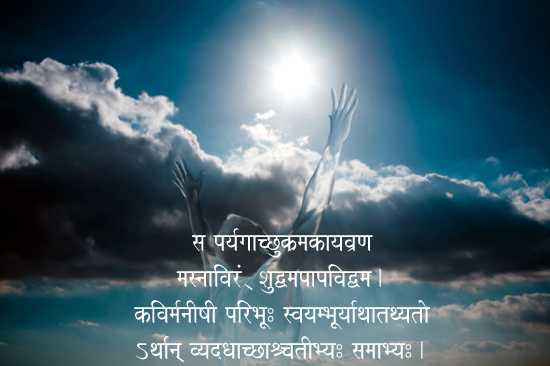Dec 22, 2025
Dec 22, 2025

Sa paryagac-chukram-akayam–avranam
asna-viragm suddham-apapa-viddham,
kavir manisi paribhuh svayam-bhuh yatha-tathyatah
arthan vyadadhac-chasva-tibhyah samabhyah (8)
He, the Atman is all pervading;
self-sufficient, scathe-less, without a body,
without blemish, radiant, knowing all, seeing all, and encompassing all.
He has duly assigned their respective duties to the Prajapati.
Commentary
This particular shloka attempts at a comprehensive description of the Eternal in terms of meaningful phraseology of words. The seer has tried to describe the Self, the Atman in us in most appealing sweet and short words, full of symbolic meaning and details.
The word Prayagat used herein simply indicates the one who has gone out or abroad but here it simply means the one who has spread out far and wide with no limit or extent, or beyond all boundaries. Another word Sukram means bright. Bright is the light but It suggests the brightness of Self. The Self is not the bright light but the effulgence that shines through and remains a light-giving principle. Scathe-less and without muscle suggests that its withering away or coming into any harmful injury is impossibility as it has no fibrous tissue with ability to contract or produce any movement even. It indicates an immune nature and therefore it is suddha and pure, being without a physical form. It remains untouched by evils.
The seer describes the Self with the use of the words, prayagati, Akayam, Scathe less, without muscles, Suddha, pure, Appa-viddhan meaning immaculate, unpierced by evils, and perfectly clean and faultless.
The seer sees the Atman as bodiless – the three bodies, gross, subtle and causal are absent in its case. The Atman is above and beyond it and is therefore perfect. The seer says that the Self is the seer. In this world appearance, Jeeva is the vehicle of consciousness, Jeeva has ego-sense, and intelligence is the vehicle of ego-sense, mind of intelligence, prana of mind, senses of prana; body, senses and motion become vehicle of body and such a motion is called Karma, action. As a life-principle, the Prana, being the vehicle of mind, when takes away the mind then the mind is merged with the spiritual heart, prana does not move at all, then mind attains quiescent state. Self is thus the life principle and the only seer.
Self is also the knowing principle. It is omniscient. It appears without any cause; therefore is Reality which is alone, is. Atman is the First Cause, Causeless Cause, Primeval. It is Pure Conscious Awareness and is all-pervading; nothing pervading It.
The question arises, how do we know or realize the Self? Do we know ‘It’ by any external aid or by any other self or by Itself.
We are all unanimous that the Self cannot be known by not-self or by anything external to self. It may be body, mind, intellect senses. We know that all these are inert and insentient. The inert cannot know anything. Then the question arises, is there more than one Self? How do we know it ; do we know from the presence of another third Self? Then this goes on; proving it a wrong assumption.
Then there remains the only alternative that there is only one Self and none else. We can realise the Self by the Self in the Self. Self is both the knower and the known; the seer and the seen; the cognisor and the cognised at the same time. It is Pure Consciousness, non-dual, homogeneous and indivisible.
Self is self-luminous, shines bright all the times. It is the External light that reveals the world, body, senses and mind and intellect but is not revealed by them. It can be said that Self is Vishva at working level; Tejas at dreaming level; and Prajna at deep sleep level. These are layers of Awareness and not the alternative states for a person to step into. They examine the depths in the cosmos and the unconscious mind.
Self is all-pervading and nothing pervades It. It is said that, “That which is not consciousness of internal world, nor consciousness of the external world, nor consciousness of both the worlds, nor a mass of consciousness nor consciousness nor unconsciousness ,which is unseen, beyond empirical dealings, beyond reach of organs, unchanging, auspicious, non-dual, - That is the Self and that is to be intuited.”
The indivisible Consciousness exists everywhere. Self is all-pervading and it is the essence that holds everything together. That is also the creation; all this is the ever peaceful and blissful Brahman. It is the only moving finger behind the universe. It moves all natural phenomenon according to its law of nature Rita; Rta or rhythm displays a clear sense of ordered universe. It anticipates the Karmic laws and preserves the rule of creation. Rig Veda (x-190-3-) mentions, “Just as God created the sun, the earth, the moon, the electricity, the atmosphere, in the previous cycle, so He has done in the present and so He will do it in the future. His work is all flawless and absolutely without any error.”
Previous: Isha Upanishad Shloka 7
Next: Isha Upanishad Shloka 9
Image (c) Gettyimages.com
16-Apr-2011
More by : Dr. R. K. Lahri

|
Very nice and best shlok you are great writer |

|
shri hari krishna changmai had asked something. if possible pl let him know: 'ruchinambaichitradrijukutilananapathajushang nrinameko gamyastamasi payasamarnaba iba' spelling are not fully correct thanks |

|
Revered Dr. R. K. Lahri Your explanation on the sloka carries a supream morality. Sir, I want to have the original sanskrit sloka which carries the meaning as follow- " all streams though having different sources and takes different path ultimately reach the sea. Accordingly all followers of different religions come to me at the end." Request to take the pain to mail the sloka to the above mail id. |

|
Thanks for enlightening us! My gratitude! |